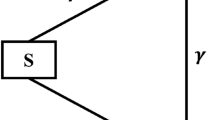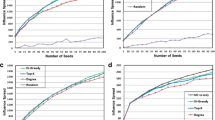Abstract
This paper investigates how various consumer behaviors influence sales volume in social commerce through information dissemination. We use a modified SIR dynamic model to study these effects and how they vary under different maximum message lifetimes and as the number of network nodes varies. We conduct parameter sensitivity analysis to measure the influences of consumer behaviors on the sales volume. The simulation results indicate that consumer behaviors during information dissemination can significantly influence the outbreak size of the information and the sales volume. Specifically, a higher information-spread probability will increase the outbreak size of the message. A higher first-purchase probability could accelerate the increase in sales volume, especially when the maximum message lifetime is long and the number of nodes is large. Besides, the regular-purchase behavior has a positive impact on the acceleration, while the discard-information behavior after the first purchase has an opposite effect. We verify our model using data collected from two websites: Sina Weibo and Taobao. This study helps social commerce marketers understand how consumer behaviors can influence sales volume through information spread and aids them in modeling this mechanism.














Similar content being viewed by others
References
Liang, T., & Turban, E. (2011). Introduction to the special issue social commerce: A research framework for social commerce. International Journal of Electronic Commerce, 16(2), 5–14.
Wang, R., Rho, S., Chen, B.-W., & Cai, W. (2017). Modeling of large-scale social network services based on mechanisms of information diffusion: Sina Weibo as a case study. Future Generation Computing Systems, 74, 291–301.
Mamonov, S., & Benbunan-Fich, R. (2017). Exploring factors affecting social e-commerce service adoption: The case of Facebook Gifts. International Journal of Information Management, 37(6), 590–600.
Liang, T.-P., Ho, Y.-T., Li, Y.-W., & Turban, E. (2011). What drives social commerce: The role of social support and relationship quality. International Journal of Electronic Commerce, 16(2), 69–90.
Song, T., Yi, C., & Huang, J. (2017). Whose recommendations do you follow? An investigation of tie strength, shopping stage, and deal scarcity. Information & Management, 54(8), 1072–1083.
Choon, J., Ng, Y., Meng, M., Huang, D., & Liu, Y. (2016). The ‘feminine’ entrepreneurial personality trait: The competitive advantage of female college-student entrepreneurs in Chinese wei-shang businesses? Asian Business & Management, 15(5), 343–369.
Lien, C. H., & Cao, Y. (2014). Examining WeChat users’ motivations, trust, attitudes, and positive word-of-mouth: Evidence from China. Computers in Human Behavior, 41, 104–111.
Lee, S. Y. T., & Phang, C. W. (2015). Leveraging social media for electronic commerce in Asia: Research areas and opportunities. Electronic Commerce Research and Applications, 14(3), 145–149.
China E-Commerce Research Center. (2018). China social commerce industry development report in 2017. http://b2b.toocle.com/detail--6405503.html. Accessed 15 Dec 2018.
IResearch. (2018). China E-commerce industry report. http://news.iresearch.cn/content/2018/02/273033.shtml. Accessed 15 Dec 2018.
Kim, D. (2013). Under what conditions will social commerce business models survive? Electronic Commerce Research and Applications, 12(2), 69–77.
Culnan, M. J., Mchugh, P. J., & Zubillaga, J. I. (2010). How large U.S. companies can use Twitter and other social media to gain business value. MIS Quarterly Executive, 9(4), 243–259.
Zhao, N., & Cui, X. (2017). Impact of individual interest shift on information dissemination in modular networks. Physica A: Statistical Mechanics and its Applications, 466, 232–242.
Xiong, F., Liu, Y., & Zhang, H.-F. (2015). Multi-source information diffusion in online social networks. Journal of Statistical Mechanics: Theory and Experiment, 2015(7), P07008.
Daley, J., & Gani, D. J. (2001). Epidemic modelling: An introduction. Cambridge: Cambridge University Press.
Cheng, X., Fu, S., & de Vreede, G.-J. (2017). Understanding trust influencing factors in social media communication: A qualitative study. International Journal of Information Management, 37(2), 25–35.
Zhou, L., Zhang, P., & Zimmermann, H.-D. (2013). Social commerce research: An integrated view. Electronic Commerce Research and Applications, 12(2), 61–68.
Zhou, G., Xu, K., & Liao, S. S. Y. (2013). Do starting and ending effects in fixed-price group-buying differ? Electronic Commerce Research and Applications, 12(2), 78–89.
Herrando, C., Jiménez-Martínez, J., & Martín-De Hoyos, M. J. (2017). Passion at first sight: How to engage users in social commerce contexts. Electronic Commerce Research, 17(4), 701–720.
Hildebrand, C., Häubl, G., Herrmann, A., & Landwehr, J. R. (2013). When social media can be bad for you: Community feedback stifles consumer creativity and reduces satisfaction with self-designed products. Information Systems Research, 24(1), 14–29.
Huang, Z., & Benyoucef, M. (2013). From e-commerce to social commerce: A close look at design features. Electronic Commerce Research and Applications, 12(4), 246–259.
Huang, Z., & Benyoucef, M. (2017). The effects of social commerce design on consumer purchase decision-making: An empirical study. Electronic Commerce Research and Applications, 25, 40–58.
Gorner, J., Zhang, J., & Cohen, R. (2013). Improving trust modeling through the limit of advisor network size and use of referrals. Electronic Commerce Research and Applications, 12(2), 112–123.
Tian, X., & Liu, L. (2017). Does big data mean big knowledge? Integration of big data analysis and conceptual model for social commerce research. Electronic Commerce Research, 17(1), 169–183.
Pastor-Satorras, R., & Vespignani, A. (2001). Epidemic spreading in scale-free networks. Physical Review Letters, 86(14), 3200–3203.
Parshani, R., Carmi, S., & Havlin, S. (2010). Epidemic threshold for the susceptible-infectious-susceptible model on random networks. Physical Review Letters, 104(25), 258701.
Zanette, D. H. (2002). Dynamics of rumor propagation on small-world networks. Physical Review E, 65(4), 041908.
Castellano, C., Fortunato, S., & Loreto, V. (2009). Statistical physics of social dynamics. Reviews of Modern Physics, 81(2), 591–646.
Zhou, T., Liu, J.-G., Bai, W.-J., Chen, G., & Wang, B.-H. (2006). Behaviors of susceptible-infected epidemics on scale-free networks with identical infectivity. Physical Review E, 74(5), 056109.
Satsuma, J., Willox, R., Ramani, A., Grammaticos, B., & Carstea, A. (2004). Extending the SIR epidemic model. Physica A: Statistical Mechanics and its Applications, 336(3–4), 369–375.
Rizzo, A., Frasca, M., & Porfiri, M. (2014). Effect of individual behavior on epidemic spreading in activity-driven networks. Physical Review E, 90(4), 042801.
Li, M., Orgun, M. A., Xiao, J., Zhong, W., & Xue, L. (2012). The impact of human activity patterns on asymptomatic infectious processes in complex networks. Physica A: Statistical Mechanics and its Applications, 391(14), 3718–3728.
Funk, S., Salathé, M., & Jansen, V. A. A. (2010). Modelling the influence of human behaviour on the spread of infectious diseases: A review. Journal of the Royal Society, Interface, 7(50), 1247–1256.
Sotiriadis, M. D., & van Zyl, C. (2013). Electronic word-of-mouth and online reviews in tourism services: The use of twitter by tourists. Electronic Commerce Research, 13(1), 103–124.
Daugherty, T., & Hoffman, E. (2014). eWOM and the importance of capturing consumer attention within social media. Journal of Marketing Communications, 20(1–2), 82–102.
Yang, F. X. (2017). Effects of restaurant satisfaction and knowledge sharing motivation on eWOM intentions. Journal of Hospitality & Tourism Research, 41(1), 93–127.
Wang, Q., Xu, Z., Cui, X., Wang, L., & Ouyang, C. (2017). Does a big Duchenne smile really matter on e-commerce websites? An eye-tracking study in China. Electronic Commerce Research, 17(4), 609–626.
Zhang, K. Z. K., Benyoucef, M., & Zhao, S. J. (2016). Building brand loyalty in social commerce: The case of brand microblogs. Electronic Commerce Research and Applications, 15, 14–25.
Libai, B., et al. (2010). Customer-to-customer interactions: Broadening the scope of word of mouth research. Journal of Service Research, 13(3), 267–282.
Bruce, N. I., Foutz, N. Z., & Kolsarici, C. (2012). Dynamic effectiveness of advertising and word of mouth in sequential distribution of new products. Journal of Marketing Research, 49(4), 469–486.
Jin, S.-A. A., & Phua, J. (2014). Following celebrities’ Tweets about brands: The impact of Twitter-based electronic word-of-mouth on consumers’ source credibility perception, buying intention, and social identification with celebrities. Journal of Advertising, 43(2), 181–195.
Li, F., & Du, T. C. (2011). Who is talking? An ontology-based opinion leader identification framework for word-of-mouth marketing in online social blogs. Decision Support Systems, 51(1), 190–197.
Bampo, M., Ewing, M. T., Mather, D. R., Stewart, D., & Wallace, M. (2008). The effects of the social structure of digital networks on viral marketing performance. Information Systems Research, 19(3), 273–290.
Yang, J., Zhuang, D., Xie, W., & Chen, G. (2013). A study of design approach of spreading schemes for viral marketing based on human dynamics. Physica A: Statistical Mechanics and its Applications, 392(24), 6494–6505.
Zhu, Z. (2013). Discovering the influential users oriented to viral marketing based on online social networks. Physica A: Statistical Mechanics and its Applications, 392(16), 3459–3469.
Wang, Z. S., Zhao, H., Lai, Z. W., & Qin, X. Z. (2016). Improved SIR epiDEM model of social network marketing effectiveness and experimental simulation. Systems Engineering-Theory & Practice, 36(8), 2024–2034.
Marathe, M., & Vullikanti, A. K. S. (2013). Computational epidemiology. Communications of the ACM, 56(7), 88.
van der Lans, R., van Bruggen, G., Eliashberg, J., & Wierenga, B. (2010). A viral branching model for predicting the spread of electronic word of mouth. Marketing Science, 29(2), 348–365.
Campbell, A. (2013). Word-of-mouth communication and percolation in social networks. American Economic Review, 103(6), 2466–2498.
Trusov, M., Bucklin, R. E., & Pauwels, K. (2009). Effects of word-of-mouth versus traditional marketing: Findings from an internet social networking site. Journal of Marketing, 73(5), 90–102.
Marsden, P. (2009). Top social commerce survey findings. https://Socialcommercetoday.com Online. Available: https://digitalwellbeing.org/top-social-commerce-survey-findings-ripple6/. Accessed 15 Dec 2018.
Liang, T., & Lai, H. (2002). Effect of store design on consumer purchases: An empirical study of on-line bookstores. Information & Management, 39(6), 431–444.
Darley, W. K., Blankson, C., & Luethge, D. J. (2010). Toward an integrated framework for online consumer behavior and decision making process: A review. Psychology & Marketing, 27(2), 94–116.
Wen, C., Prybutok, V. R., Blankson, C., & Fang, J. (2014). The role of E-quality within the consumer decision making process. International Journal of Operations & Production Management, 34(12), 1506–1536.
Engel, J. F., Blackwell, R. D., & Miniard, P. W. (1995). Consumer behavior (8th ed.). Fort Worth, TX: Harcourt Education.
Wu, Y., Deng, S., & Huang, H. (2012). Information propagation through opportunistic communication in mobile social networks. Mobile Networks and Applications, 17(6), 773–781.
Xin, W., Member, Z., Li, S., He, Y., & Chang, E. Y. (2015). Connecting social media to e-commerce: Cold-start product recommendation using microblogging information. IEEE Transactions on Knowledge and Data Engineering, X(X), 1–14.
Liang, K., Jiang, C., & Lin, Z. (2016). The nature of sellers’ cyber credit in C2C e-commerce: The perspective of social capital. Electronic Commerce Research, 17(1), 133–147.
Zhou, L., Zhang, D., Yang, C., & Wang, Y. (2017). Harnessing social media for health information management. Electronic Commerce Research and Applications, 27, 139–151.
Acknowledgments
The authors thank reviewers and editors for their valuable and constructive comments. This research is supported by the General Program of Natural Science Foundation of China (Grant No. 61471083), Program of the Ministry of Education of China (Grant No. 14YJA630044).
Author information
Authors and Affiliations
Corresponding author
Ethics declarations
Conflict of interest
On behalf of all authors, the corresponding author states that there is no conflict of interest.
Additional information
Publisher’s Note
Springer Nature remains neutral with regard to jurisdictional claims in published maps and institutional affiliations.
Rights and permissions
About this article
Cite this article
Zhao, N., Li, H. How can social commerce be boosted? The impact of consumer behaviors on the information dissemination mechanism in a social commerce network. Electron Commer Res 20, 833–856 (2020). https://doi.org/10.1007/s10660-018-09326-3
Published:
Issue Date:
DOI: https://doi.org/10.1007/s10660-018-09326-3





